Korean Reading Made Simple Volume 1, Edition 1 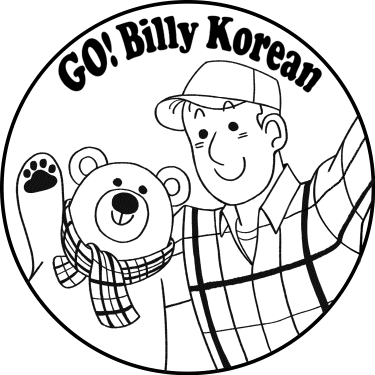 Written by: Billy Go Artwork and editing by: Sohyun Sohn Cover design by: Joel Tersigni Cover artwork by: Heejin Park (heejindraws.tumblr.com) Published by: GO! Billy Korean Copyright 2019 GO! Billy Korean www.gobillykorean.com All rights reserved This book is also available in printed form (ISBN: 9781675282779) from Amazon.com and other retail outlets. E-Book Edition, License Notes This E-book is licensed for your personal enjoyment only. This E-book may not be re-sold or given away to other people. If you would like to share this book with another person, please purchase an additional copy for each recipient. If youre reading this book and did not purchase it, or it was not purchased for your use only, then please return to your favorite E-book retailer and purchase your own copy. Thank you for respecting the hard work of this author.
Written by: Billy Go Artwork and editing by: Sohyun Sohn Cover design by: Joel Tersigni Cover artwork by: Heejin Park (heejindraws.tumblr.com) Published by: GO! Billy Korean Copyright 2019 GO! Billy Korean www.gobillykorean.com All rights reserved This book is also available in printed form (ISBN: 9781675282779) from Amazon.com and other retail outlets. E-Book Edition, License Notes This E-book is licensed for your personal enjoyment only. This E-book may not be re-sold or given away to other people. If you would like to share this book with another person, please purchase an additional copy for each recipient. If youre reading this book and did not purchase it, or it was not purchased for your use only, then please return to your favorite E-book retailer and purchase your own copy. Thank you for respecting the hard work of this author.
Table of Contents Preface  Welcome back! Or if youre seeing me for the first time, ! Im Billy, and Im here to help you along your Korean language journey! Im so glad to see that youre seeking out more resources (such as this one, and hopefully others) to continue studying and practicing the language. Did you know that the majority of Korean learners give up in the very early stages, such as while learning the alphabet or basic grammar? There are many reasons that happens, and I wont judge those who do especially because I know myself how difficult learning Korean can be at times. The fact that youve conquered the basics and are now working hard to pass through the intermediate (or advanced) level is something that you can and should feel proud of. Always remember the reasons why youre learning Korean, and use that to help motivate yourself to keep going. Learning Korean is a lot like trying to level up in a video game its easy in the beginning, then gets progressively harder. When you first started learning it might have only taken a few hours or days to memorize and some useful phrases.
Welcome back! Or if youre seeing me for the first time, ! Im Billy, and Im here to help you along your Korean language journey! Im so glad to see that youre seeking out more resources (such as this one, and hopefully others) to continue studying and practicing the language. Did you know that the majority of Korean learners give up in the very early stages, such as while learning the alphabet or basic grammar? There are many reasons that happens, and I wont judge those who do especially because I know myself how difficult learning Korean can be at times. The fact that youve conquered the basics and are now working hard to pass through the intermediate (or advanced) level is something that you can and should feel proud of. Always remember the reasons why youre learning Korean, and use that to help motivate yourself to keep going. Learning Korean is a lot like trying to level up in a video game its easy in the beginning, then gets progressively harder. When you first started learning it might have only taken a few hours or days to memorize and some useful phrases.
Perhaps you were able to even put together a complete simple sentence after a few weeks of studying. Everything was moving so quickly. However, past the beginning stages things can feel slower; you start to need more and more time and effort to notice yourself improving and to reach that next level. But in order to push past those barriers it will not only require more studying, but also more exposure to the language. This exposure includes speaking, writing, listening, and reading each are helpful and important. When it comes to reading, theres a lot more out there than just Korean novels.
In this book alone youll explore newspaper articles, journal entries, emails, poems, folk tales, social media posts, and even comics. The more variety you have, the better. Through the resources in this book youll not only be able to improve your general reading comprehension, but youll also be increasing your exposure to a wider variety of written content (including ones you may not have tried yet). And finally, its my hope that youll be able to gain a greater appreciation for written materials in the Korean language. Good luck in your studies! What You Can Expect It can be difficult jumping straight into native-level materials, whether youre intermediate or even advanced. This book is meant to be a bridge to allow learners to explore completely natural, real-life reading resources along with explanations, translations, and definitions.
Imagine trying to read something that was written for a native Korean speaker (not simplified for a beginner) and having a personal tutor right by your side to walk you through it thats this book. Each resource comes together with translations, definitions, and explanations for both its vocabulary and grammar forms all tailored specifically to a Korean learner (thats you). This will help any learner with basic grammar and vocabulary under their belt (and a dictionary) to dive into the deep end and experience true and natural reading materials in Korean. In order to save space, grammar and vocabulary will be defined and explained briefly within the context of the resource; concepts will be covered enough to be able to fully comprehend each resource. English translations will be more literal than natural this is to help you understand the Korean content more easily. Natural translations will also be provided occasionally.
The Korean language uses different phrases and grammar than English even the way Koreans think when speaking and writing is unique and I wanted to preserve that in the English translations as much as possible. This book should not be used as a standard textbook if youre still moving through the beginner level; instead I recommend my Korean Made Simple textbook series which goes from the very beginning of the language up to the intermediate level (or you can use any textbook and resources youd like). Before using this book you should first be able to have simple, basic Korean conversations (even if very slowly); this typically happens around the lower intermediate level. Tips for Using This Book Keep a Korean dictionary handy while using this book. While most vocabulary words in this book will be defined, simpler and more common words or grammar forms will not be. Also I recommend that you refer to the glossary section whenever you find a word or grammar form that youre not familiar with the number next to each entry is the number of the resource it first appears in (listed in the Table of Contents).
Words and grammar defined in a previous chapter of this book will not be defined again in later chapters. Because of this, I recommend moving through these resources in the order theyre given without skipping any (but dont let me tell you what to do). Try not to rush. Itd be much better to read through the resources and explanations slowly so that you can understand them. I recommend first reading each resource on your own before looking at any of the translations or explanations. Or if youre already at a higher level, try reading the resource on its own two or three times, and then only relying on the explanations or definitions when you get stuck.
The Plain Form Youll often find the Plain Form used in many written resources. The Plain Form is especially common in newspaper articles, essays, journals, and short stories. Its used whenever theres no specific intended audience. The Plain Form includes using instead of (when spoken, is typically only used in casual speech) as well as ending verbs with when conjugating. Heres a (very) quick overview of how to conjugate the Plain Form. For the present tense, attach to a verb stem that ends in a vowel, or attach to a verb stem that ends in a consonant.
Verb stems ending with will remove the and attach . + + + For the past tense, first conjugate the verb as usual (using the form), cut off any syllable after the ending, and then attach . However, (to be) becomes after a consonant or after a vowel. (to not be) simply becomes . + + + or or + or + Additional Questions? Feel free to contact me 24/7 with any questions you have and Ill try to get back to you (but give me a day or so to check my email). I love helping people like you to learn Korean, and appreciate your support through purchasing this book.
You can find my contact information in the About the Author section at the back of this book.  The Haenam Kim Rabbit Family, Episode 1 is a county in southwestern Korea known for its seafood and dried seaweed or laver. This is to suggest the black spots on the rabbits ears might be actual . In addition, could also mean a (Kim) family whose genealogy is from . = dried seaweed, (dried) laver = episode counter , . can be used to refer to ones husband or wife similarly to saying honey or sweetheart although its not commonly used between younger married couples. () is a combination of meaning to attend (school) or to commute (to work) and meaning to come. () is a combination of meaning to attend (school) or to commute (to work) and meaning to come.
The Haenam Kim Rabbit Family, Episode 1 is a county in southwestern Korea known for its seafood and dried seaweed or laver. This is to suggest the black spots on the rabbits ears might be actual . In addition, could also mean a (Kim) family whose genealogy is from . = dried seaweed, (dried) laver = episode counter , . can be used to refer to ones husband or wife similarly to saying honey or sweetheart although its not commonly used between younger married couples. () is a combination of meaning to attend (school) or to commute (to work) and meaning to come. () is a combination of meaning to attend (school) or to commute (to work) and meaning to come.
Next page
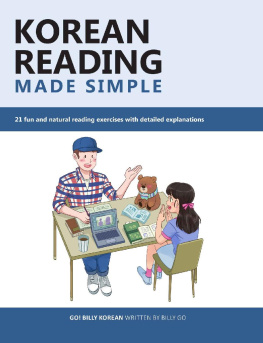
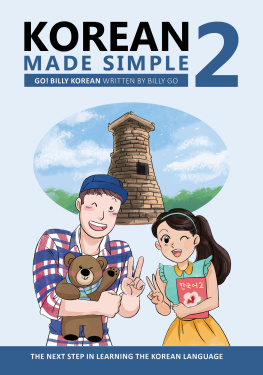
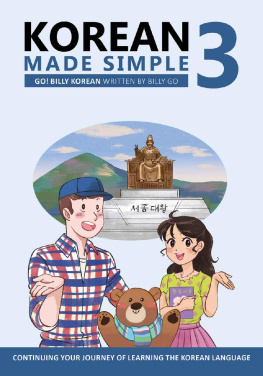
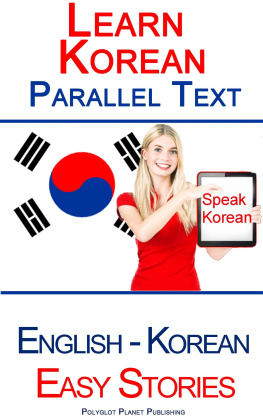

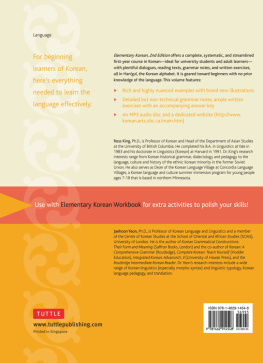
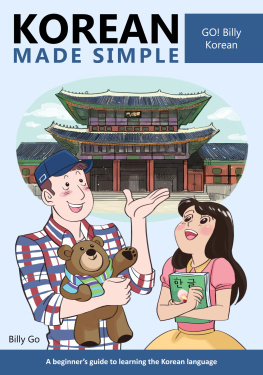
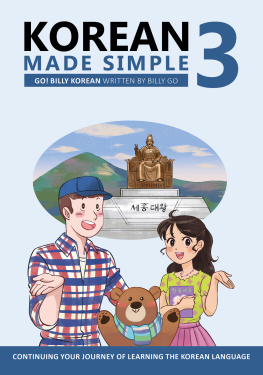
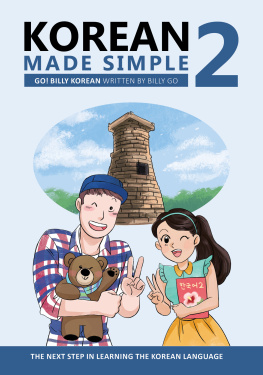
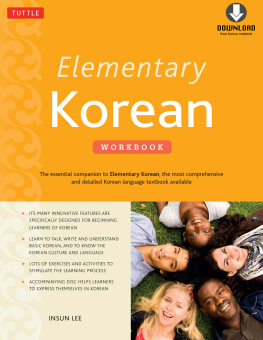
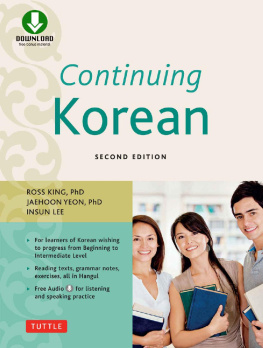
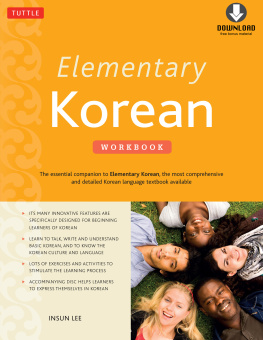
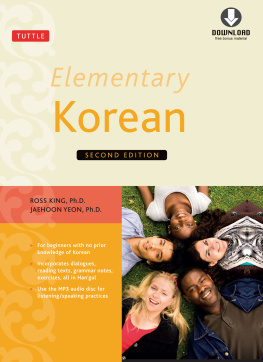
 Written by: Billy Go Artwork and editing by: Sohyun Sohn Cover design by: Joel Tersigni Cover artwork by: Heejin Park (heejindraws.tumblr.com) Published by: GO! Billy Korean Copyright 2019 GO! Billy Korean www.gobillykorean.com All rights reserved This book is also available in printed form (ISBN: 9781675282779) from Amazon.com and other retail outlets. E-Book Edition, License Notes This E-book is licensed for your personal enjoyment only. This E-book may not be re-sold or given away to other people. If you would like to share this book with another person, please purchase an additional copy for each recipient. If youre reading this book and did not purchase it, or it was not purchased for your use only, then please return to your favorite E-book retailer and purchase your own copy. Thank you for respecting the hard work of this author.
Written by: Billy Go Artwork and editing by: Sohyun Sohn Cover design by: Joel Tersigni Cover artwork by: Heejin Park (heejindraws.tumblr.com) Published by: GO! Billy Korean Copyright 2019 GO! Billy Korean www.gobillykorean.com All rights reserved This book is also available in printed form (ISBN: 9781675282779) from Amazon.com and other retail outlets. E-Book Edition, License Notes This E-book is licensed for your personal enjoyment only. This E-book may not be re-sold or given away to other people. If you would like to share this book with another person, please purchase an additional copy for each recipient. If youre reading this book and did not purchase it, or it was not purchased for your use only, then please return to your favorite E-book retailer and purchase your own copy. Thank you for respecting the hard work of this author. Welcome back! Or if youre seeing me for the first time, ! Im Billy, and Im here to help you along your Korean language journey! Im so glad to see that youre seeking out more resources (such as this one, and hopefully others) to continue studying and practicing the language. Did you know that the majority of Korean learners give up in the very early stages, such as while learning the alphabet or basic grammar? There are many reasons that happens, and I wont judge those who do especially because I know myself how difficult learning Korean can be at times. The fact that youve conquered the basics and are now working hard to pass through the intermediate (or advanced) level is something that you can and should feel proud of. Always remember the reasons why youre learning Korean, and use that to help motivate yourself to keep going. Learning Korean is a lot like trying to level up in a video game its easy in the beginning, then gets progressively harder. When you first started learning it might have only taken a few hours or days to memorize and some useful phrases.
Welcome back! Or if youre seeing me for the first time, ! Im Billy, and Im here to help you along your Korean language journey! Im so glad to see that youre seeking out more resources (such as this one, and hopefully others) to continue studying and practicing the language. Did you know that the majority of Korean learners give up in the very early stages, such as while learning the alphabet or basic grammar? There are many reasons that happens, and I wont judge those who do especially because I know myself how difficult learning Korean can be at times. The fact that youve conquered the basics and are now working hard to pass through the intermediate (or advanced) level is something that you can and should feel proud of. Always remember the reasons why youre learning Korean, and use that to help motivate yourself to keep going. Learning Korean is a lot like trying to level up in a video game its easy in the beginning, then gets progressively harder. When you first started learning it might have only taken a few hours or days to memorize and some useful phrases. The Haenam Kim Rabbit Family, Episode 1 is a county in southwestern Korea known for its seafood and dried seaweed or laver. This is to suggest the black spots on the rabbits ears might be actual . In addition, could also mean a (Kim) family whose genealogy is from . = dried seaweed, (dried) laver = episode counter , . can be used to refer to ones husband or wife similarly to saying honey or sweetheart although its not commonly used between younger married couples. () is a combination of meaning to attend (school) or to commute (to work) and meaning to come. () is a combination of meaning to attend (school) or to commute (to work) and meaning to come.
The Haenam Kim Rabbit Family, Episode 1 is a county in southwestern Korea known for its seafood and dried seaweed or laver. This is to suggest the black spots on the rabbits ears might be actual . In addition, could also mean a (Kim) family whose genealogy is from . = dried seaweed, (dried) laver = episode counter , . can be used to refer to ones husband or wife similarly to saying honey or sweetheart although its not commonly used between younger married couples. () is a combination of meaning to attend (school) or to commute (to work) and meaning to come. () is a combination of meaning to attend (school) or to commute (to work) and meaning to come.